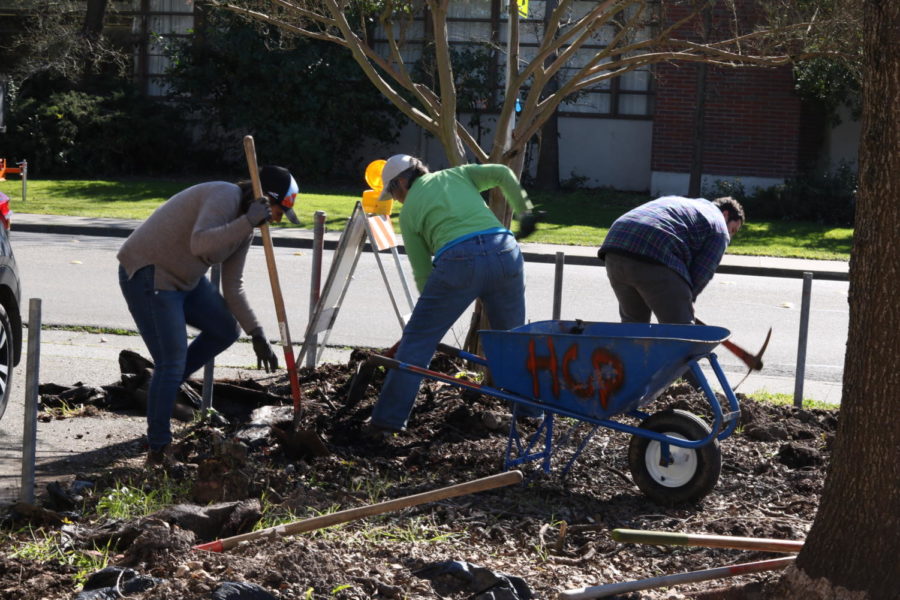For Santa Rosa Junior College students, walking down Elliott Avenue isn’t exactly a scenic path. Overgrown weeds, invasive shrubbery and brittle blades of yellow grass grimace at students meandering between classes.
Not only are the front yards of these SRJC-owned faculty houses unpleasant, they also are not fire safe or drought friendly. SRJC, Habitat Corridor Project and the Santa Rosa Water Agency are going to change that.
This semester, SRJC’s sustainability department has decided to rework the front and back yards of four properties on Elliott Avenue, creating eight new landscapes for the community to enjoy. These landscapes are intended to be fire safe, conserve water and act as community models for those who are rebuilding their homes due to fire loss or who want to grow a sustainable garden.
All of the landscape designs are accessible online at livinglearninglandscapes.com, and are intended to work in any yard space in Sonoma County. The plans are free and include affordable plant options along with alternatives that work anywhere.
Mimi Enright, University of California master gardener, created four of the designs while April Owens, executive director of Habitat Corridor Project, created the remaining.
UC Master Gardeners such as Enright often get called in to lend their expertise to community projects. Master Gardeners are mandated by the government to educate the community on horticulture. The master gardener program started in 1980 in Washington and quickly spread to Sonoma County in 1982. To become a Master Gardener, one must apply to the program and a chosen 30 applicants undergo a crash course on house horticulture which occurs every other year.
Enright says that the Master Gardeners were brought in by Owens and were thrilled to work on a project in such a central location. She and 15 other Master Gardeners dove head first into learning about fire resistant landscaping for about a year to work on this project. “Our whole mission is around extending knowledge to residents,” Enright said.
These garden instillations are not just going to make Elliott Avenue more aesthetically pleasing, but they also serve an important purpose. California’s perfect recipe of drought weather and dry air makes it perfect for fires, yet these gardens contain features that are intended to halt or delay on-coming flames.
Climate Corps Fellows Sloane Pagal and Allison Jenks are two of the many powerhouses behind the project in its physical stages. They are working under program supervisor David Leibman, hitting the ground running to make sure the gardens receive the funding and attention they need.
In terms of money, both women know it’ll be an expensive project. “We’re applying [for grants]. It’s a decent chunk of change,” Jenks said.
Funding this project will mostly come from grants and community donations. Pagal and Sloane have currently applied for a grant on 425 Elliott Ave. as those garden designs are more focused on fire resistance.
“The costs are significant,” Pagal said. “Luckily, with volunteers that covers the labor cost.”
When it comes to applying these gardens designs to the average person’s home, Jenks and Pagal believe it can be done at a low cost. Both women agree the landscape plans provide affordable California native plant options. The Master Gardeners program hosts an annual plant sale on April 13 at Martial Cottle Park in San Jose. Lots of tools for gardening can also be found on Craigslist or Facebook.
Aside from budget, Pagal and Jenks, with help from volunteers, are prepping the gardens for planting this spring. The first step in this garden makeover is to remove all of the invasive species.
“We had some of the ivy ripped out, and we’re kind of getting ready to do the instillation,” Pagal said.
They have currently laid out cardboard on the lawns to keep invasive species from growing. After these unwanted plants have been kicked to Elliott’s curb, the next step will be irrigating the gardens in March, laying down sheet mulch in early April and beginning planting later that same month.
The plan is to have two gardens at 1808 Elliott Ave. and 427 Elliott Ave. finished by this summer. However, once all the gardens are finished, those involved worry about the long term management.
Habitat Corridor Project is in charge of maintaining the gardens for the first five years; after that it is SRJC’s responsibility. While there is ambiguity about how the garden will be managed after that, Jenks is confident that students will have a major impact on these gardens.
“The whole goal is that we want them to continue to look good,” Jenks says. “This project will continue to give back to the community.”
Above everything, the project and those involved are most concerned about educating the community and SRJC students. SRJCs horticulture class will be involved in the irrigation process coming up in March; students will get a grade for helping on this project.
“We don’t want to just come in, have these landscapes installed, and then they’re just something nice to look at,” Pagal says. “We want to engage the students. We have two classes coming in and learning how to do irrigation.”
Not only will students be involved, but faculty members are being offered additional paid hours of work to volunteer for the project.
Pagal realizes that the most exciting time to be a volunteer will be in late spring, but she says that volunteers are needed at every step of the way.
Both Pagal and Jenks say the best time to volunteer is “Every Thursday!” when they meet 11 a.m. to 3 p.m. at the corner of Elliott Avenue and Albany Drive. Hours are flexible; gloves and additional tools are provided. For more information on volunteering, email [email protected].





Lina Hoshino • Mar 12, 2019 at 7:11 pm
This is a great idea! What are the fire resistant and native species they are planting? How about making it a demonstration garden with plant identifying signage so that passersby can learn?
Jill Kelly-Moore • Mar 12, 2019 at 6:24 pm
“Not only are the front yards of these SRJC-owned faculty houses “???? WE have FACULTY HOUSES ? Are faculty living in them? THis is the first I have heard of this and I have been on this campus since 1990.